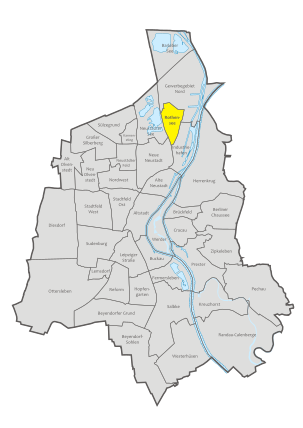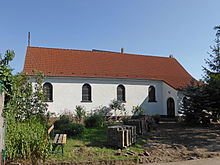Rothensee
|
Rothensee district of Magdeburg |
|
|---|---|
| Basic data | |
| Surface: | 2.1223 km² |
| Residents : | 2752 |
| Population density : | 1,297 inhabitants per km² |
| (Information as of December 31, 2016) | |
| Coordinates : | 52 ° 11 ' N , 11 ° 40' E |
| Districts / Districts: | Alt Rothensee Hillersleber Strasse settlement Rothensee industrial area Windmühlenstrasse station Rothensee |
| Postal code : | 39126 |
| Tram lines : | 10 |
| Bus routes : | 704 ( NJL ) |
Rothensee is a district in the north of the state capital Magdeburg with an area of 2.1223 km² and 2,752 inhabitants (as of December 31, 2016).
geography
The district lies at a height of 44 meters above sea level in the fork of the tracks of the Magdeburg – Stendal railway line and the industrial railway. In the south, the Pettenkofer Bridge forms the end, while the Barleber See district adjoins it in the north . The actual town center, located in the northeast of the district, is approximately one square kilometer, while the Windmühlenstraße settlement is located in the southern area. Magdeburg city center is 6.5 kilometers away.
Infrastructure
Rothensee has the character of a suburban settlement. Although the Rothenseer industrial area is always used in common parlance, the district has no business settlements apart from the railway operating site in the west . These are located in the east and north of the industrial harbor , industrial area north and Barleber See. The main traffic artery is the August-Bebel-Damm, which creates the connection to Magdeburg city center and via which the A 2 motorway can be reached (junction Magdeburg-Rothensee; 3.6 km away). With the Eichenweiler and Rothensee stops there is a connection to the Mittelelbe S-Bahn , as well as a tram route through the district.
history
The name of the place comes from the old Saxon and means something like "at the red lake". The lake is probably meant to be a bathing lake that was created from an old Elbarm and is still reminiscent of the Badeteichstraße today. The town was founded in the 12th century at the latest, because "Rodense" is mentioned in a copy of a document from the Archbishop of Magdeburg Wichmann († 1192) from 1176 . At that time, Dutch settlers were recruited in order to be able to use their experience in cultivating areas close to the water for the development of the place. The landlords were the Knights of Rothensee, whose gender can be traced back to 1313. The first village church was built around 1300. Until the end of the 13th century, the village was east of the Elbe and thus in the area of the Mark Brandenburg . At this time the Elbe shifted its course further east, so that Rothensee was finally on the west bank of the river and thus came under the rule of the Archdiocese of Magdeburg.
During the Thirty Years' War there was also destruction in Rothensee. The church burned down in 1631. In 1683 there were already 46 house owners. In 1731 a fire destroyed almost the entire place. Due to its proximity to the Elbe, Rothensee had suffered from the threat of flooding for centuries. A first improvement in the situation came with a river regulation carried out in 1788, with which the course of the river was moved even further east. Nevertheless, a flood in 1845 caused severe damage to the village. As a result, the Magdeburg-Rothensee-Wolmirstedter Deichverband was founded, which built a flood-proof dike by 1862.
Until the 19th century, the forest area of the Rothenseer Busch was an important economic factor, both for logging and as a hunting area. After the forest was cut down at the beginning of the 19th century, agriculture began to gain in importance. By 1860, 700 hectares of Rothensee were already being used for agriculture.
After the defeat of Prussia by Napoleon I , Rothensee came from 1806 to the Kingdom of Westphalia owned by Napoleon's brother Jerome. When the French were expelled eight years later and Prussia ruled again, Rothensee was integrated into the Wolmirstedt district as part of the Prussian administrative reform of 1815 . Nevertheless, the place was in the catchment area of Magdeburg, especially since with the industrialization and the connection to the Magdeburg – Stendal railway line in 1897, an ever closer integration developed. Logically, Rothensee was incorporated into Magdeburg in 1908. A year later the dilapidated medieval church was torn down and replaced by a new building, which was completed in 1910. On August 8 of the same year, after a three-year construction period, a new marshalling yard for Magdeburg with 69.5 kilometers of track was opened on the western periphery of Rothensee. At the same time, the place received a new passenger station on Oebisfelder Strasse. The entire construction project cost 6.25 million Reichsmarks. As a result of the factories that have now been built nearby, more and more people settled in Rothensee, and the population quadrupled within eighty years to 2,552 in 1925.
Newly built housing estates met the increased demand for living space. In 1921, the construction of the residential area Windmühlenstrasse began, which was carried out by the tenant construction and savings association. In 1937, the lignite-petrol company had the so-called BRABAG settlement built. Magdeburg's well-known architect Johannes Göderitz also left his mark in 1925 when he built a school. On May 1, 1941, a tram ran between Rothensee and Magdeburg for the first time.
In 1944, a satellite camp of the Buchenwald and Auschwitz concentration camps was set up in Rothensee , where up to 4,000 concentration camp prisoners were housed ( Magda concentration camp ). In addition, a prisoner of war and a forced labor camp were operated. Most of the inmates had to work in the BRABAG factory . The bombing raids on Magdeburg in 1944 and 1945 did little damage to Rothensee itself. Important strategic goals such as the marshalling yard and the BRABAG plant were severely damaged in a bombardment on April 18, 1945. On the same day it was occupied by American troops.
There were few structural changes in the district during the GDR era. In 1953 the Catholic Rosary Chapel was built by converting a horse stable. In 1960 an allotment garden was created, in 1975 a small residential estate was built and in the early 1980s some prefabricated buildings were built. A western bypass was set up in 1971 to separate long-distance rail traffic from the tracks of the marshalling yard. As the previous Rothensee passenger station lost its function, two new stops were created in the south and north of the district on the newly laid long-distance railway line. The old-established agriculture was continued in the course of the forced collectivization from 1958 by an LPG , which last cultivated around 400 hectares. At the beginning of the 1970s, one of the largest German steel foundries was built on August-Bebel-Damm to replace the foundries in Magdeburg's urban area. The annual output of this company was increased to up to 40,000 t. However, after the political change in 1989 , production was stopped. In the early 2000s, a large-scale production facility for the wind energy industry was set up on this site.
Rothensee legend
The name of the district is said to go back to the legend of the dragon . This dragon-like monster was killed by a bold warrior, the princess was freed and the evil one was defeated. The blood of the dragon formed a red lake that is said to have been visible for centuries. The ally of the evil robber baron was a powerful wizard whose castle was destroyed. The village of Rothensee was built on its ruins.
Significant structures
The cultural monuments that exist in Rothensee are listed in the local register of monuments.
- In Turmstrasse, the historic center of Rothensee, the Protestant Reformation Church, built as a historic brick building from 1909 to 1910, stands on the former cemetery surrounded by a quarry stone wall.
- The oldest building in the village is the Rothensee tower house , also located on Turmstrasse , a residential tower that was built around 1200 as part of a courtyard of the Magdeburg Dompropstei.
- The elementary school (today August-Bebel-Schule) built by Johannes Göderitz in 1925 can be found in Windmühlenstraße. It consists of several single-storey, staggered class wings made of red brick. The building is considered a classic example of rural school building in the 1920s. The facility also included a 2-storey residential building for the teaching staff. It was at the southern end of the school grounds. An electric alarm siren was installed on the roof. An explosive bomb destroyed half of the house on January 16, 1945. The air raid shelter was in the undamaged other half of the building, so the seven people there remained unharmed. The remaining part of the building was torn down and not rebuilt.
- The Rothensee ship lift , inaugurated in 1938 , as well as the Rothensee sluice gate completed in 2001 , part of the Magdeburg waterway intersection .
- Wind turbine of the type Enercon E-126 with a rotor diameter of 127 meters, a hub height of 135 meters and a total height of almost 200 m on the Enercon factory premises. It is not only the tallest structure in Magdeburg, but also one of the most powerful wind turbines in the world with a generator output of 7.5 MW.
people
Born in Rothensee:
- Friedrich Wilhelm Schneider (1801–1879), forest scientist and mathematician
- Ernst Fresdorf (1889–1967), Lord Mayor of Brandenburg an der Havel and senior municipal official.
Literature, sources
- Magdeburg and its surroundings (= values of our homeland . Volume 19). 1st edition. Akademie Verlag, Berlin 1973.
- History of the City of Magdeburg , Akademie-Verlag Berlin, 1977
- Magdeburg - architecture and urban development , Janos Stekovics publishing house, 2001, ISBN 3-929330-33-4
- Georg Dehio: Handbook of German Art Monuments, Saxony-Anhalt I, Deutscher Kunstverlag, 2002, ISBN 3-422-03069-7
- CD Saxony-Anhalt - Official Topographic Maps , State Office for Land Surveying and Geoinformation, 2003
- Tobias Bütow, Franka Bindernagel: A concentration camp in the neighborhood. The Magdeburg satellite camp of Brabag and the "Freundeskreis Himmler". Böhlau, Cologne, 2003; 2nd edition 2004. ISBN 3-412-04904-2 ( Review by Christine Wolters at H-Soz-u-Kult )
Web links
Individual evidence
- ↑ District catalog of the Office for Statistics
- ↑ Rosenkranzkapelle Rothensee , on johannes-bosco-magdeburg.de








